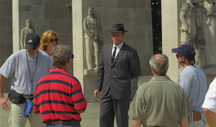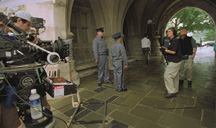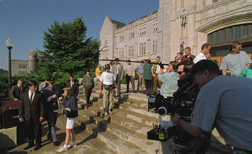|
Tech jumps in U.S. News ratings In U.S. News and World Report's latest ranking of undergraduate programs at U.S. public universities, Virginia Tech is 28tha leap from 40th position last year. U.S. News also ranked Tech's College of Engineering as 18th in the nation among U.S. schools with Ph.D. programs, a jump from 21st last year. Moving up one notch in the business-school ranking, the Pamplin College of Business was ranked 45th out of 327 accredited undergraduate business schools. Earlier this year, the magazine ranked Tech's Center for Public Administration and Policy in the top 20 nationally for its master's degree in public administration and policy. Back to Contents Racing money to aid vet college Money from betting at Virginia's Colonial Downs horseracing track will soon go to support new facilities at the Virginia-Maryland Regional College of Veterinary Medicine. Much of this year's $240,000 allocation made by the Virginia General Assembly will support the development of new equine teaching and research facilities at Virginia Tech. The remaining funds will assist in planning and engineering work for an isolation facility at the Marion duPont Scott Equine Medical Center in Leesburg. Virginia's horse industry contributes more than $1 billion in sales to businesses and individuals in virtually every locality in the commonwealth, according to a 1995 study. Back to Contents
Ping Chong, one of America's most renowned contemporary theatre artists, was in residence in September with Tech's theatre-arts department. He came to Blacksburg from New York to complete a new visual theatre piece that explored American culture, society, and violence. The residency culminated in the world premiere of American Gothic on the Tech campus. American Gothic was created in collaboration with Michael Rohd, founder and artistic director of Hope is Vital and an MFA candidate in directing at Virginia Tech, and Jeffrey Wiseman, an actor and visiting artist from Kent State University. Chong is now at the forefront of experimental theatre, and his New York-based company has won worldwide acclaim for its visually arresting multi-media stage productions that examine history through image and allusion. Back to Contents Tech gains site license for Cuba travel Students, faculty, and researchers wanting to travel to Cuba for academic reasons will now have an easier time gaining official permission. Virginia Tech's Department of Urban Affairs and Planning has received a site license by the U.S. Department of the Treasury for granting permission for educational travel to Cuba. Joseph Scarpaci, professor of urban affairs and planning, will handle all Virginia Tech requests for licenses to travel to the island, which has been under severe travel restrictions by the United States since 1961. "It will be similar to a clearinghouse for all Virginia Tech academic activity in Cuba," Scarpaci says. "Previously, the approval process was lengthy and seemingly arbitrary. The delays irritated students and parents and complicated travel arrangements, usually on charter flights through third countries." Chemical engineering professor William Velander, the first to travel under the new site license, will visit Cuba in December to speak with officials there on establishing a graduate student exchange and post-doctoral study program in agricultural biotechnology and engineering science. Virginia Tech is one of the first U.S. institutes of higher education to receive such a license. Tech has the nation's longest running study abroad program in Cuba. Scarpaci has led 10 such programs and has visited the island 23 times for research. Back to Contents Faculty members honored with special rank The Virginia Tech Board of Visitors conferred the special rank of University Distinguished Professor (UDP) on nine faculty members and appointed one Alumni Distinguished Professor (ADP). The UDP status is conferred for exceptional achievements and performance over a career in which faculty have been recognized nationally and internationally. Only one percent of faculty may receive this rank. Alumni Distinguished Professors also have a stellar record of scholarship but are selected in particular for their contributions to the instructional program and their influence on the lives of generations of Virginia Tech students. Those receiving UDP status were: Robert Bodnar, geological sciences; Harold Burkhart, forestry; Nikki Giovanni, English; David Kingston, chemistry; Fred Lee, electrical and computer engineering; Timothy Luke, political science; Thomas Ollendick, psychology; Arun Phadke, electrical and computer engineering; and Garth Wilkes, chemical engineering. Arthur Buikema Jr., of biology, received Alumni Distinguished Professor status. Back to Contents Virginia's "Wireless Valley" scores another coup Virginia's "Wireless Valley," stretching along the New River and Roanoke Valleys, is another $1 million richer. The National Science Foundation has awarded Virginia Tech's Electrical and Computer Engineering and Computer Science departments a three-year grant to enhance wireless communications systems. According to Ted Rappaport, the project's principal investigator and founder of Virginia Tech's Mobile and Portable Radio Research Group, this award will allow researchers to develop new software engineering tools that will enable wireless engineers to predict system performance and capacity before actual wireless hardware is installed. Such tools will allow rapid deployment of wireless systems in neighborhoods, campuses, and cities throughout the world. The research results will be applied to the expansion of the Local Multipoint Distribution Service broadband wireless spectrum that Virginia Tech purchased at auction in 1998. Experts predict that within 10 years there will be close to one billion wireless subscribers. Today, about 300 million wireless phones and 850 million traditional telephone lines are in place globally. Back to Contents Virginia Tech faculty members who are studying growth factors in human cells, speeding up image transmissions, investigating bacteria's response to environmental signals, and developing single semiconductor chips that can house personal communications systems have received National Science Foundation Faculty Early Career Development Program awards this year. These four-year grants, worth $200,000-$500,000 each, are presented annually to a select group of about 350 faculty members nationwide who have demonstrated early in their careers the potential to make significant contributions to engineering and scientific research and instruction. Ann Stevens, an assistant professor of biology, is interested in the way bacteria sense and respond to environmental signals, and her research revolves around the idea that bacterial cells are capable of intercellular communication and coordinated behavior as multi-cellular units. She will incorporate into biology's instructional curriculum the latest findings and theories coming from emerging research fields. Kimberly Forsten (chemistry '88), assistant professor of chemical engineering, uses experimental and mathematical modeling to study growth factors and determine how they can be effectively transported from blood to underlying tissue. Her NSF grant project will include developing a biotechnology track of elective courses for chemical engineering undergraduates. Husband and wife team Amy Bell and Sanjay Raman are assistant professors of electrical and computer engineering and are among the few married couples ever to win NSF Career grants in the same year. Bell will use her grant to incorporate her expertise in electronic signals and image compression into a senior design course. With the support of his NSF grant, Raman will attempt to develop methods of integrating antennas with the electronics used in wireless devices in order to put all of the components of wireless technology on single-chip systems. He will also develop a graduate course in radio-frequency integrated circuit design. Back to Contents Motorola gives $1.3 million in equipment Motorola Inc. has given Virginia Tech 25 semiconductor manufacturing tools with a total book value of $1.3 million. The university will use the tools in two new "clean rooms" to be constructed with funds from Motorola, the Virginia Microelectronics Consortium (VMEC), and the Pratt Fund. "If we had to buy these tools new, we would probably pay 10 times the book value," said Robert Hendricks, professor of electrical and computer engineering and of materials science and engineering. One clean room, in Whittemore Hall, will be used for teaching introductory undergraduate courses in semiconductor technology. The other, in Hancock Hall, will serve as an advanced undergraduate and graduate research facility. Hendricks expects the facilities to be in operation by fall semester 2000. Back to Contents Vet college studies the human-animal bond Americans love their pets. As a trip to any pet supply store, veterinary office, or pet cemetery shows, people tend to treat their pets as part of the family. Now, a new academic curriculum in the Virginia-Maryland Regional College of Veterinary Medicine will study the complex relationship between humans and animals. Marie Suthers-McCabe will head the curriculum, which is a joint effort with Virginia Commonwealth University's Medical College of Virginia. The therapeutic value of pets is an emerging area of scientific study. Pets are now used to "humanize" hardened criminals, to reach out to emotionally disturbed children, and to cheer the elderly. In her new position, Suthers-McCabe will help develop a curriculum in animal assisted therapy and education, work with the vet college's Pet Loss Grief Hotline, develop pet and farm animal visits for inner-city children, and continue to research human-animal interaction. Tech recently kicked off a three-year series of symposiums titled "The Bridge between Veterinary Medicine and Human Health," which will feature speakers from around the nation, including the assistant surgeon general of the United States. Back to Contents Study finds high housing costs The constant stream of economic good news the past few years may not be as bright as it seems, according to a new study by the Center for Housing Research at Virginia Tech. The findings indicate that Virginia's low-income families face extremely high housing rental costs, often spending about half of their income for a decent apartment. Similar data from the U.S. Department of Housing and Urban Development indicate that this is a nationwide trend and that fewer affordable housing units are available in all states. The full study, including maps, graphs, tables, and references, can be accessed at www.arch.vt.edu/vchr/vchr.html. Back to Contents Remote sensing aids environmental decisions The Center for Environmental Applications of Remote Sensing (CEARS) has opened as part of Virginia Tech's College of Natural Resources. NASA funded $419,256 to establish the center, located in Cheatham Hall. The center uses remote sensing technology to provide detailed geographic information, such as soil types and the locations of watersheds and wildlife habitats. CEARS provides maps and spatial data at all levelsland and water, above and below ground. "This kind of information," said Greg Brown, dean of the College of Natural Resources, "can help people make good decisions on matters that have any bearing on the environment." Spearheading the effort for Tech are Randolph Wynne, assistant professor of forestry who specializes in applying small satellite technology to the study of natural resources, and James Campbell, geography professor and department head. Back to Contents
Financial success more important to today's students An annual survey of incoming Virginia Tech students indicates that they are increasingly concerned with personal objectives and less focused on academic and societal issues. In the 1998 survey, 75.2 percent of incoming Tech students rated "being very well off financially" as "essential" or "very important"an increase from 71.6 percent in the 1994 survey. The following objectives fell in importance to new students from 1994 to 1998: "becoming an authority in my own field," "obtaining recognition from my colleagues," "developing a meaningful philosophy of life," "promoting racial understanding," and "being involved in environmental clean-up." Since 1994, the top two reasons Tech students cited for deciding to attend college have been "to get a better job" and "to make more money." In addition, students cite Tech's social and academic reputations as major factors in their decision to attend Tech. Back to Contents Tech collaboration sheds new light on early coastal inhabitants A prehistoric site on Virginia's Eastern Shore has yielded important information about the region's earliest inhabitants, and Virginia Tech's College of Architecture and Urban Studies will join in further study of that area's history, ecology, and archaeology through an agreement with the Nature Conservancy and the College of William and Mary. Since 1994, these institutions have coordinated multidisciplinary research projects on the Eastern Shore's barrier islands and coastal salt marshes. The 45,000-acre Virginia Coast Reserve has been designated a World Biosphere Reserve by the United Nations. The discovery of two glass beads within the reserve in Northampton County indicates that early inhabitants of the peninsula traded with others in the region that is now New York and Pennsylvania. The glass beads are of Dutch origin and were used extensively for trade among northern settlements. Preserved garbage-filled pits and posts found on the site indicate the presence of a permanent settlement dating to about 1,000 years ago. Research opportunities exist in environmental, marine, and the natural sciences, as well as archaeology, history, and anthropology. Ornithologists study the many species of birds that nest in the region during the summer and migrate through in the spring and fall. Past projects have included cultural resource management, architectural analysis, resource analysis, historic use of public land, and collaborations with towns and villages on improvement of low-cost housing and sustainable development. Back to Contents Twenty-one students in assistant professor Missy Cummings' engineering fundamentals class used what they dubbed the "cram factor" to fit themselves into a new Volkswagen Beetle. The Volkswagen "stuffing" was more than an attempt at setting a world's record––Cummings used it as a class project to teach her students some basic engineering principles. Based on the class's previous calculations, only about 17 of them should have fit inside. The world's record is 24, set by a group of female Asian dancers. Back to Contents Together with Wavtrace, a commercial developer of local multi-point distribution service (LMDS) equipment, Virginia Tech researchers have conducted successful tests of Tech's LMDS network to deliver wireless dataincluding voice, video, and Internetfrom a hub site on the Tech campus to three off-campus office buildings. The LMDS network is a two-way, high bandwidth, wireless networking service in the 28-31 GHz range of the radio-frequency spectrum. Tech is the only university in the nation to own LMDS spectrum licenses. Hopes are pinned on LMDS technology to provide fast and affordable wireless Internet access to many locations, including rural areas, for economic and social benefit. Applications for the new technology include distance learning, tele-medicine, and videoconferencing. For more information, visit www.lmds.vt.edu/. Back to Contents Home | News | Features | Research | Philanthropy | Athletics | Alumni | Classnotes | Editor's Page |




